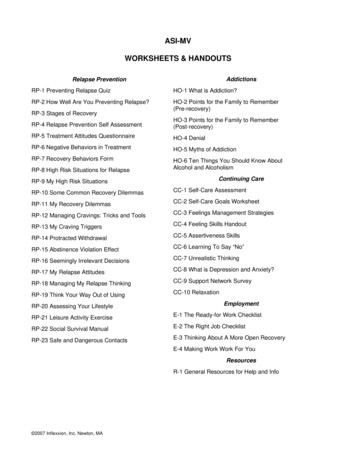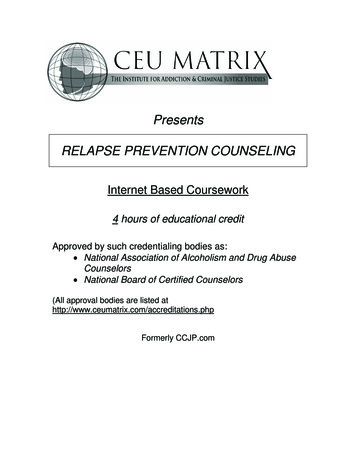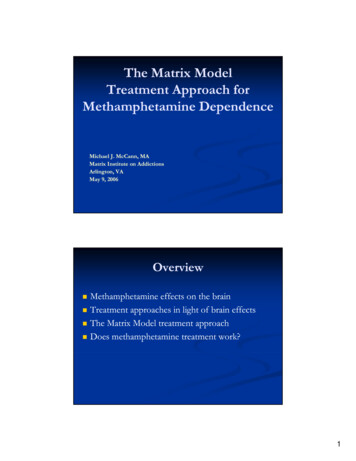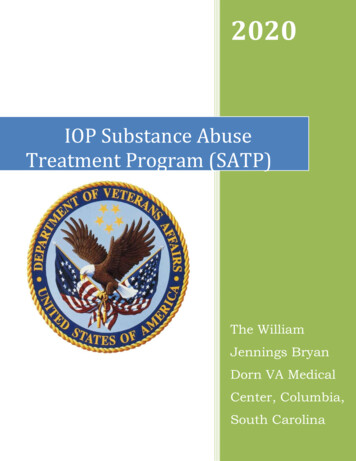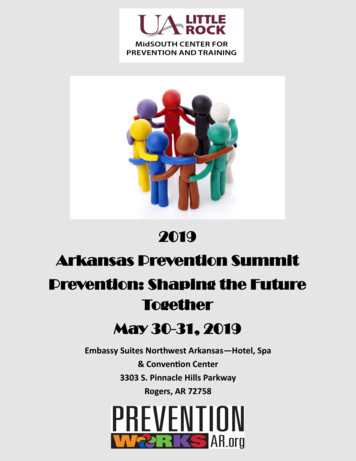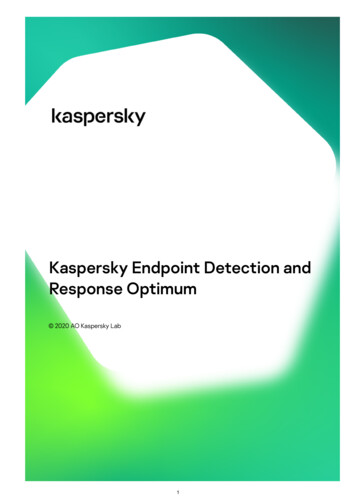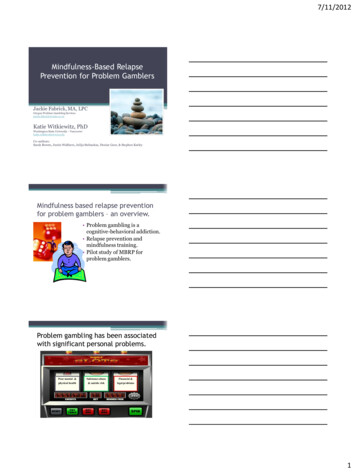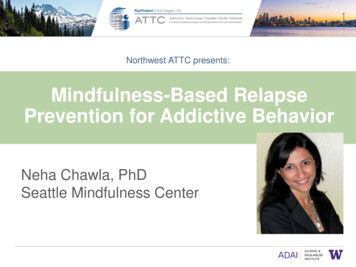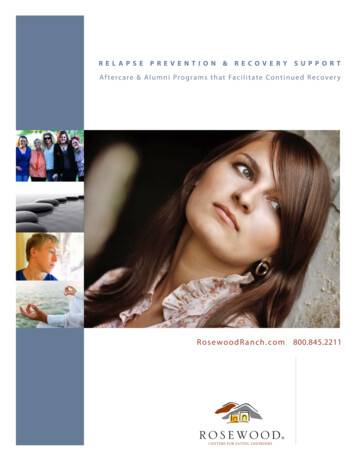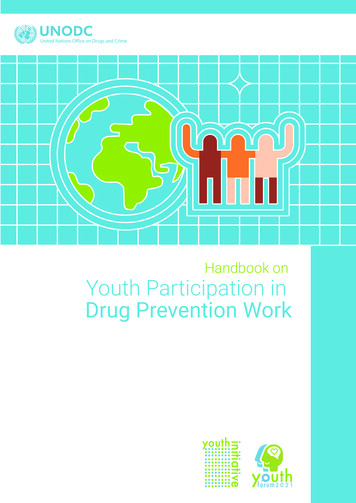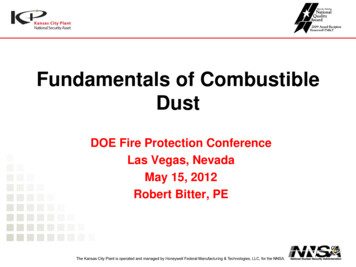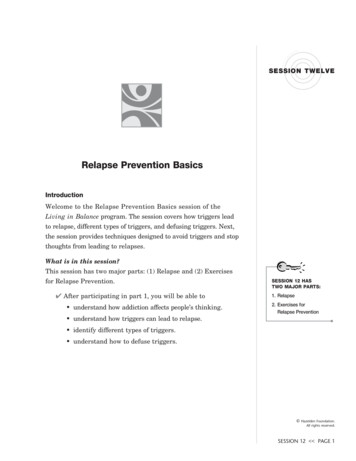
Transcription
SESSION TWELVERelapse Prevention BasicsIntroductionWelcome to the Relapse Prevention Basics session of theLiving in Balance program. The session covers how triggers leadto relapse, different types of triggers, and defusing triggers. Next,the session provides techniques designed to avoid triggers and stopthoughts from leading to relapses.What is in this session?This session has two major parts: (1) Relapse and (2) Exercisesfor Relapse Prevention.4 After participating in part 1, you will be able to understand how addiction affects people’s thinking. understand how triggers can lead to relapse.SESSION 12 HASTWO MAJOR PARTS:1. Relapse2. Exercises forRelapse Prevention identify different types of triggers. understand how to defuse triggers. Hazelden Foundation.All rights reserved.SESSION 12 PAGE 1
LIVING IN BALANCE4 After participating in part 2, you will be able to understand how to avoid triggers. understand visualization exercises. understand how thought-stopping can help youprevent thoughts from becoming triggers.What will be asked of you?You will be asked to review how triggers can lead to relapse,different types of triggers, and techniques to avoid and defusetriggers. Because triggers are personal and can be emotionalissues, reviewing this information can be challenging. However,reviewing this information can help you learn one of the mostimportant skills in recovery: stopping the triggers that lead torelapse.Part 1: RelapseAs a reminder, addiction is a process that involves (1) compulsionto drink alcohol or use other drugs, (2) a loss of control overdrinking alcohol or using drugs, and (3) continued drinking orLEARNER OBJECTIVESFOR PART 1:You will understand how addictionaffects people’s thinking. understand how triggerscan lead to relapse. identify different typesof triggers. understand how todefuse triggers.drug use despite negative consequences.In addition, addiction involves (1) obsessive thinking aboutdrinking alcohol and using drugs and (2) relapse, or a return toalcohol or drug use after a period of not drinking or using.Addiction affects people’s thinking. For example, addictioncan make people feel that if they don’t drink alcohol or use drugsfor a few days or weeks, their problems are over. However,stopping drinking alcohol and using drugs does not mean thatthe addiction is over. Rather, not drinking alcohol and usingdrugs is the beginning of the recovery process. Hazelden Foundation.All rights reserved.PAGE 2 SESSION 12
RELAPSE PREVENTION BASICSEXERCISE 1Select yes or no for the following question:In your opinion, is there a difference between (1) beingalcohol- and drug-free and (2) being in recovery?YesNoIndeed, a healthy recovery requires people to change theirA healthy recoverylife styles to avoid behaviors, people, places, and things that canrequires people to changetrigger relapse. Making these changes in attitudes and lifestylestheir lifestyles to avoidrequires a lot of support and a lot of work.behaviors, people, places,Learning relapse-prevention techniques will help you learnnew ways of coping with drug cravings and develop new skillsand things that cantrigger relapse.to prevent relapse.EXERCISE 2Please answer the following questions:1. What in your life today will most likely lead you to relapse?Explain.2. What are you doing to prevent that from happening? Hazelden Foundation.All rights reserved.SESSION 12 PAGE 3
LIVING IN BALANCE3. Should you be doing more to prevent relapse fromhappening?YesNo (If yes, please explain.)TriggersAll recovering people have certain people, places, emotions, andthings that are somehow associated with drinking alcohol or usingdrugs. These people, places, things, and feelings are so closelyassociated with substance use that they can trigger thoughtsabout using. These high-risk people, places, things, and feelingsare called triggers.How do triggers lead to relapse? Triggers automatically lead to thoughts aboutsubstance use.All recovering peoplehave certain people, places,emotions, and things that aresomehow associated withsubstance use. Thoughts about alcohol or other drugs lead to craving. Craving can lead to relapse.Remember that using alcohol or other drugs causes chemicalchanges in the brain. These changes may make you morevulnerable to relapse. These changes may be memories orassociations that connect feelings, people, places, and thingswith the urge to use substances. Theseare actual physical changes inthe brain that make you morelikely to relapse. Therefore,it is critical to put intoplace strategies to preventrelapse. Hazelden Foundation.All rights reserved.PAGE 4 SESSION 12
RELAPSE PREVENTION BASICSEXERCISE 3Please answer the following questions:1. In your words, describe (1) how triggers lead to thoughtsabout substance use, (2) how these thoughts lead tocravings, and (3) how cravings lead to relapse.2. What do you think are some ways that you can interruptthis cycle?It is critical to putinto place strategiesto prevent relapse. Hazelden Foundation.All rights reserved.SESSION 12 PAGE 5
LIVING IN BALANCEAn internal trigger is an emotional state that you might experi Internal triggers areence before, during, or after substance use. You may have felt veryemotional states thathappy, depressed, anxious, or sexually aroused while you wereyou might experienceusing. Later, these feelings can remind you of substance use.before, during, or aftersubstance use.EXERCISE 4Please answer the following question:What is one of your strong internal triggers?External triggers include events, places, things, or specific timesthat you associate with substance use. For instance, these triggersExternal triggers includeevents, places, things,or specific times thatyou associate withsubstance use.might include the neighborhood where you drank alcohol orbought drugs, a bar, a dealer’s apartment, a payday, or weekendevenings. Items connected to substance use, such as a smokyroom, injection equipment, or a crack pipe, are often strong triggersfor substance thoughts and cravings. External triggers alsoinclude specific people who were involved in your substance use.EXERCISE 5Please answer the following question:What is one of your strong external triggers? Hazelden Foundation.All rights reserved.PAGE 6 SESSION 12
RELAPSE PREVENTION BASICSSensory triggers are related to the senses of sight, sound, smell,taste, and touch. These are sensations that remind you of drugSensory triggers areuse. Sensory triggers may include the look of white powders, asensations—sight, sound,specific type of music, and certain smells and tastes.smell, taste, and touch—that remind you of a drug.EXERCISE 6Please answer the following question:What is one of your strong sensory triggers?EXERCISE 7Please answer the following questions:1. What are some triggers that have been especially difficultfor you to deal with in the past?2. What are some triggers that are especially difficult foryou to deal with now? Hazelden Foundation.All rights reserved.SESSION 12 PAGE 7
LIVING IN BALANCEDefusing TriggersTriggers automatically lead to drug thoughts, drug thoughts leadto drug cravings, and cravings lead to relapse. However, thereare steps you can take to stop this chain of events.Identify triggers. To maintain your sobriety, you needTo maintain yoursobriety, you needto be able to recognizeand identify your personalto be able to recognize and identify your personal triggers fordrug use. You should be aware of what people, places, and thingstrigger thoughts of drugs and understand when these triggersoccur and what makes them worse.triggers for drug use.EXERCISE 8Please do the following:Quickly list one internal, one external, and one sensorytrigger.Avoid triggers. Triggers are signs of danger. Whenever possible,avoid all high-risk situations, high-risk people, and other triggers.EXERCISE 9Please do the following:1. Name three situations you can simply avoid. Hazelden Foundation.All rights reserved.PAGE 8 SESSION 12
RELAPSE PREVENTION BASICS2. Name three people you can simply avoid.Interrupt triggers. Some triggers, such as specific days of theweek, certain times of the day, or specific feelings, cannot beavoided. These triggers can be interrupted, however, by engagingin a healthy activity to counter the effect of the trigger. Forexample, you can attend a self-help meeting on Fridays becausethat day is associated with using drugs.EXERCISE 10Please do the following:Name three healthy activities you can engage in.Talk about triggers. If you want to be able to stop triggersfrom causing a drug craving, you need to be able to talkTriggers will remainabout them. By talking about them, you can betterpowerful if you don’tunderstand what’s going on and reduce their power.talk about them.Triggers will remain powerful if you don’t talkabout them. Hazelden Foundation.All rights reserved.SESSION 12 PAGE 9
LIVING IN BALANCEEXERCISE 11Please do the following:Name three people you can talk to when you have cravings.Thought-stopping. A trigger leads you to think about drugs.A trigger leads you tothink about drugs, whichwill lead to cravings, andThese thoughts will lead to craving and relapse if you continueto obsess about drugs. The good news is that these thoughts canbe interrupted using relaxation and visualization exercises.eventually to relapse.EXERCISE 12Please answer the following questions:1. What are some techniques that have helped you to avoidtriggers? What are some techniques that did not work? Hazelden Foundation.All rights reserved.PAGE 10 SESSION 12
RELAPSE PREVENTION BASICS2. What are some techniques that have helped you to inter rupt triggers you can’t avoid? What are some techniquesthat did not work?Part 2: Exercises for Relapse PreventionAvoiding TriggersWhat’s the easiest way not to experience triggers? Avoid them!When is it easiest to stop triggers from leading to cravings?Before you experience them!The best time to stop a trigger from leading to relapse iseither before you experience the trigger or before the triggerleads to a craving. Thus, one of the best relapse-preventiontechniques is to avoid high-risk triggers entirely.Sometimes this requires making dramatic changes in yourenvironment or lifestyle. You may have to move to anotherplace to live. You may even have to relocate—actually move toanother town or city to avoid drug-using situations. Sometimesthis is the only way to avoid high-risk situations.LEARNER OBJECTIVESFOR PART 2:You will understand how toavoid triggers. understandvisualization exercises. understand howthought-stoppingcan help you preventthoughts frombecoming triggers. Hazelden Foundation.All rights reserved.SESSION 12 PAGE 11
LIVING IN BALANCEEXERCISE 13Please answer the following question:One of the bestrelapse techniquesis to avoid high-risktriggers entirely.What is the easiest way to avoid a trigger?Every day you will make important decisions about yourrecovery. Many of these decisions may seem simple and unimportant, but they are often very important. As you makedecisions, you may find it helpful to think, “Is this good for myrecovery, or is it bad for my recovery?”EXERCISE 14Please answer the following questions:1. What is a high-risk trigger for you?2. What small decisions would ultimately lead you to facethat trigger?Ask yourself,“Is this good for myrecovery, or is it badfor my recovery?” Hazelden Foundation.All rights reserved.PAGE 12 SESSION 12
RELAPSE PREVENTION BASICS3. How might different decisions lead to avoiding thistrigger?Relapse Prevention ExerciseThe best way to stop a trigger from leading to relapse is to avoidthe trigger in the first place. However, some people, places,things, and feelings may suddenly trigger drug thoughts. Oneway to stop these thoughts from developing into cravings is tointerrupt or stop the thoughts as soon as they start.Visualization is one way to interrupt or stop the thoughts, byimagining a light switch. When the switch is ON, you experiencecravings. When you turn that switch OFF, you no longer havethose cravings.Imagine a large switch that looks like a light switch. Thisis your switch, and only you can turn this switch ON and OFF.Imagine that this switch can turn your thoughts about drinkingand drugs ON and OFF.Whenever you begin to think about drinking or using drugs,you can imagine this mental switch. You can imagine yourselfswitching it from ON to OFF, and stopping the alcohol or drugthoughts. Hazelden Foundation.All rights reserved.SESSION 12 PAGE 13
LIVING IN BALANCEEXERCISE 15Please answer the following questions:1. Describe a situation in which something triggered thedesire or urge to use.2. How did you handle that situation? Hazelden Foundation.All rights reserved.PAGE 14 SESSION 12
RELAPSE PREVENTION BASICS3. How could you have used a thought-stopping techniquein that situation?4. When do you think would have been the best time touse it?5. How do you think things may have turned out differently?One way to stop thoughtsabout drugs from developinginto cravings is to interruptthe thoughts as soon asthey start. Hazelden Foundation.All rights reserved.SESSION 12 PAGE 15
LIVING IN BALANCEAvoiding relapse or stopping it while it is happening is extremelydifficult. You will need help with this. That is why it is important to attend self-help groups or counseling sessions. That iswhy you need the support of your friends and family members.For people who have become addicted to alcohol or other drugs,relapse is a common experience.It is important thatyou stop a relapse assoon as you can.It is important that you stop a relapse as soon as you can.The longer you let it go on, the harder it may be to stop. It isnot helpful to put yourself down, to kick yourself, or to tell yourself that you are a failure. You have to take responsibility foryour actions and stop the process. Some times this may meanchecking into a hospital or residential treatment program. Getyourself back on track. Get yourself back into recovery.Get your life back into balance.Session 12 SummaryIn this session, you have reviewed ways in whichtriggers can lead to relapse, different types oftriggers, and techniques you can use to avoid anddefuse triggers. Because triggers are personal andcan be emotional issues, reviewing this informationmay have been challenging. However, workingthrough this session was important because ittaught you one of the most important skills that youwill need for your recovery: stopping triggers fromleading to relapse. Hazelden Foundation.All rights reserved.PAGE 16 SESSION 12
Role-Play Exercise:Social Support at WorkPreparationThree volunteers from the group will play Marcus, LaTroy, andWillie. LaTroy and Willie drink and smoke marijuana every Fridaynight. Marcus participates for a while, but he begins to change.Background and SceneFor the past two years, Marcus has been working at a warehouse,loading and unloading trucks. When he first started working at thewarehouse, Marcus met LaTroy and Willie. Every Friday after work,Marcus would join LaTroy and Willie at the nearby bar for beer. LaTroyand Willie introduced Marcus to marijuana. Because Fridays were alsopaydays, the three of them would cash their paychecks at the bar andbuy marijuana.This week, Marcus joined a treatment program for his marijuana addiction. In addition to his treatment, he’s begun attending meetings ofAlcoholics Anonymous and Narcotics Anonymous.Shortly after beginning his job at the warehouse, Marcus noticed a signnear the water cooler that said, “Addiction Got You Down? Confidentialsupport group meets after work every Friday evening at the union hallacross the street.” Marcus hadn’t paid much attention to the sign untilnow, since he understands what it means. Although interested, Marcushas not yet gone to this meeting.In addition, he has not informed LaTroy and Willie about his treatment and recovery efforts. It is Friday afternoon, and LaTroy and Willieassume that he will join them after work.Version one. Begin the role-play exercise with LaTroy and Willieurging Marcus to join them at the bar after work. Marcus tries toexplain to LaTroy and Willie (who are still drinking and smoking marijuana) that he is in recovery. They try to get him to join them for “oldtime’s sake” or for “one last time.” In this scene, Marcus tells himselfthat he will go to the bar, but he doesn’t want to use alcohol and marijuana again. Hazelden Foundation.All rights reserved.SESSION 12 PAGE 17
Version two. Conduct the role-play exercise again, but in this situation, Marcus has decided to attend the support group at the union hallafter work. Since Fridays are paydays, Marcus is scared about havingmoney on a Friday night. He is also nervous that he might changehis mind about the support group meeting once he gets his check. Inthis scene, LaTroy and Willie try to get Marcus to the bar, but Marcusrefuses and is committed to going to the support group.Suggested Questions1. What are some examples of how Marcus can work with people,not against them?2. What are some ways in which Marcus can have more supportiverelationships?3. What are some specific ways in which Marcus can prioritize andplan aspects of his recovery? Hazelden Foundation.All rights reserved.PAGE 18 SESSION 12
The session covers how triggers lead to relapse, different types of triggers, and defusing triggers. Next, the session provides techniques designed to avoid triggers and stop thoughts from leading to relapses. What is in this session? This session has two major par
